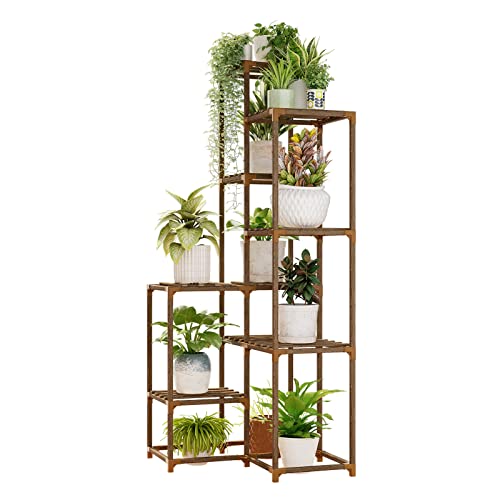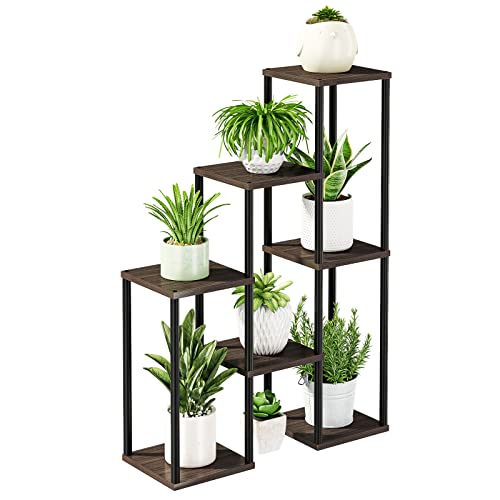The Hawaiian Spider Plant, also known as the Chlorophytum Comosum’ Hawaiian,” is a unique plant that can add a touch of tropical beauty to your home.
With its long, arched stems and spider-like leaves, this plant can exquisitely captivate anyone who looks at it.
But caring for a Hawaiian Spider Plant can be a bit tricky, especially if you’re new to plant care.
In this blog post, we’ll go over some tips and tricks on Hawaiian Spider Plant Care for keeping it healthy and thriving.
Importance of Hawaiian Spider Plant

The Hawaiian Spider Plant (Chlorophytum Comosum’ Vittatum’) is an important plant for several reasons. Here are a few of them:
- Air Purification: An excellent air purifier, this plant can help remove harmful pollutants from the air, such as formaldehyde, benzene, and carbon monoxide, improving the air quality in your home or office.
- Aesthetic Value: Due to its stunning variegated leaves and elegant long stems that generate petite plantlets, the Hawaiian Spider Plant serves as a magnificent embellishment for any area and can instill a tropical ambiance and calmness in both your residential and professional environment.
- Easy to Care For: It is an undemanding plant to maintain and preserve, rendering it a fitting alternative for novices or individuals who lack an abundance of time to devote to plant maintenance. By providing the appropriate degree of illumination, hydration, and occasional fertilization, this plant has the potential to flourish and add a delightful aesthetic touch to your surroundings.
- Stress Reduction: Numerous studies have demonstrated that exposure to plants, such as the Hawaiian Spider Plant, can lower our stress levels and boost our mood. By incorporating the Hawaiian Spider Plant into your home or professional setting, you can sustain a peaceful atmosphere and promote a sense of tranquility.
This plant is of significant importance, as it can offer a plethora of advantages ranging from air purification to stress alleviation.
Regardless of whether you possess extensive experience in plant cultivation or are simply a newbie, the Hawaiian Spider Plant is an excellent selection to supplement your collection of indoor plants.
How to Care for Hawaiian Spider Plant
1. Light Requirements
This particular plant flourishes in an environment characterized by vivid yet indirect brightness, implying that it should be stationed close to a window that receives an ample amount of natural illumination but is not directly exposed to sunlight, which could harm the plant’s leaves.
In the event that a location with bright, indirect light is not readily available, one can resort to artificial light sources such as fluorescent bulbs to provide the required light for the Hawaiian Spider Plant.
It is essential, however, to ensure that a gap of several inches is upheld between the plant and the light source to prevent the leaves from being exposed to the direct heat of the light, which could inflict harm.
2. Watering
The Hawaiian Spider Plant has a preference for damp, albeit not excessively sodden soil.
In essence, this signifies that the plant requires periodic hydration but should not be left in a position where it is submerged in stagnant water, as this could trigger root decay.
To water your beloved plant, simply saturate the soil until it is moist to the tactile sensation. Nonetheless, it is imperative to examine the soil’s condition prior to administering additional water and to only do so when it has sufficiently dried out.
Also read- How To Propagate Spider Plant In Water
The frequency of watering will depend on a multitude of factors specific to the environment of your space, such as the degree of temperature and humidity.
3. Soil Necessities
The optimal soil composition for your Hawaiian Spider Plant is a blend that has swift drainage capabilities, preventing water from accumulating on the surface and, in turn, steering excess water away from the roots.
An excellent soil mixture for this plant would encompass potting soil, perlite, and vermiculite.
When repotting your Hawaiian Spider Plant, it is imperative to ensure that the new container is only slightly larger than its current one.
A pot that is excessively large can result in overwatering, (also read overwatering vs underwatering)which could compromise the health of the plant.
4. Humidity
Hawaiian spider plants grow well in environments with high levels of humidity, though they can still flourish in settings with lower humidity levels.
In cases where your home experiences low humidity, you can heighten the moisture content around the plant by spraying it with water or by placing a humidifier in the room.
5. Fertilizing
Hawaiian spider plants do not demand an extensive routine of fertilization. However, the periodic distribution of water-soluble fertilizers can be beneficial.
6. Propagation
The Hawaiian Spider Plant is an easy plant to propagate. One can do so by detaching a “spiderette” (a small plantlet that emerges from the end of the stems) and planting it in a pot with fresh soil.
To encourage the plantlet’s growth, ensure that the soil is kept moist and warm, and within a few weeks, the new plant should commence its growth.
7. Pathology
Typically, the Hawaiian Spider Plant demonstrates resistance to pests and diseases. It may be vulnerable to infestations caused by mealybugs, spider mites, and scale insects.
To mitigate the likelihood of these pests harming your plant, keep it unsoiled and debris-free while regularly checking it for any signs of infestation.
In the event that you encounter any pests, you can eliminate them with insecticidal soap or by wiping down the plant with a solution of water and dish soap.
8. Pruning
Although not obligatory, pruning your Hawaiian spider plant can help maintain its tidy appearance.
By removing yellowing or diseased leaves and stems that no longer generate spiderettes, you can encourage the plant’s growth and maintain its good health.
9. Repotting
As your Hawaiian spider plant grows, it may outgrow its current pot, signaling the need to shift it to a slightly larger one.
When repotting, make sure to use a well-draining soil mix. The first step is to carefully remove the plant from its current pot by gently loosening the tangled roots.
Then, place the plant in its new, slightly larger pot and add the fresh soil mix. Finally, water your plant thoroughly to complete the transfer.
How to Care for Hawaiian Spider Plants at Different Stages of Growth
| Growth Stage | Light | Watering | Soil | Fertilizer | Pruning | Repotting |
| Young plant | Plenty of Sunlight | Allow soil to dry slightly between watering times | Well-draining soil mix | Fertilize every 2-4 weeks during the growing season | Not necessary | Not necessary |
| Mature plant | Bright, indirect light | the soil must be wet but avoid overwatering | Any soil mix | Fertilize every 4 weeks will be enough | Remove dead or yellowing leaves, stems that are no longer producing spiderettes | Repot into a slightly larger pot as needed |
Remember to monitor your Hawaiian Spider Plant regularly for any signs of pests, diseases, or other issues, and take appropriate action to keep your plant healthy and thriving.
Common Problems and Remedies
Here are some common problems you may encounter and tips on how to care for Hawaiian Spider Plant:
- Yellowing Leaves: There are several signs of potential problems that may arise when caring for a Hawaiian Spider Plant. One of these is yellowing leaves, which can occur if the plant is either overwatered or underwatered.
- Brown Tips on Leaves: It is vital to monitor the soil and ensure it is allowed to dry out before the next watering session. Another issue to look out for is brown tips on leaves, which can indicate low levels of humidity in the surrounding environment. In this case, increasing humidity levels can be achieved by using a humidifier or by spraying water on the plant.
- Spiderettes Not Developing: If spiderettes are not developing, it could be a sign of low light. To address this, consider relocating the plant to an area with more brightness to encourage spiderette growth.
- Curling or Wilting Leaves: If the plant’s leaves are curling or wilting, this may signify pests or diseases. It is important to inspect the plant for any signs of infestation and address the issue with an appropriate solution if necessary.
The Reason Behind Naming the Plant ‘Hawaiian Spider Plant’?
The Hawaiian Spider Plant, scientifically identified as Chlorophytum Comosum ‘Vittatum,’ is so named due to its uncanny resemblance to a spider—its slender leaves, curving stems, adorned with small plantlets or “spiderettes.”
Though originally native to South Africa, the reason behind its common name, “Hawaiian Spider Plant,” remains somewhat obscure.
It is conceivable that the plant might have been brought to Hawaii and grown in popularity there, accounting for the use of “Hawaiian” in its name.
Alternatively, it is plausible that the name was assigned to reflect the plant’s exotic look and tropical feel.
Despite the ambiguity surrounding its name, the Hawaiian Spider Plant has acquired a devoted following and remains a cherished houseplant among enthusiasts worldwide.
Hawaiian Spider Plant Care FAQs
Q: How often should I water my Hawaiian Spider Plant?
Make sure the soil is dry enough before you water your Hawaiian Spider Plant again.
Depending on your home or office conditions, this may be once a week or less.
Q: Can I propagate my Hawaiian Spider Plant?
Yes! The Hawaiian Spider Plant is easy to propagate by separating the spiderettes from the parent plant and potting them in soil.
Q: Does the Hawaiian Spider Plant need a lot of sunlight?
The Hawaiian Spider Plant thrives in bright sunlight, which is a few inches away, to avoid direct contact with the plant, but it can also grow in a lower sunlight setup.
Q: Can the Hawaiian Spider Plant grow outdoors?
The Hawaiian Spider Plant is typically grown as an indoor plant but can also be grown outdoors in warm, tropical climates.
Conclusion
Caring for a Hawaiian Spider Plant can be relatively easy if you follow the above-mentioned tips.
By providing adequate levels of light, proper watering and well-draining soil, suitable humidity, and timely fertilization, it can flourish and benefit your environment.
Consistently inspecting your plant for symptoms of pests and diseases, and taking prompt action to manage any issues, will help maintain the health and happiness of your Hawaiian Spider Plant.

My name is Olivia, and I live in the United States and love having plants in my garden. Lots of plants are there on my balcony, indoor and outdoor garden also. Here I am trying to share useful gardening tips, how to grow and care for various plants, etc.


